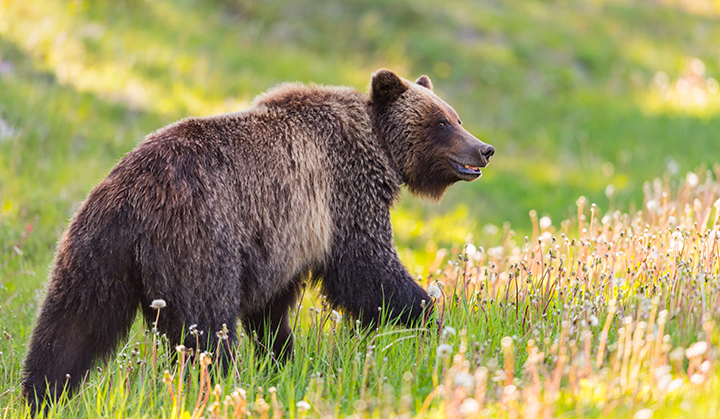Cumulative effects modeling boosts understanding of grizzly bear movement in a busy landscape
New cumulative effects modeling done by the Yellowstone to Yukon (Y2Y) Conservation Initiative and ALCES Land-Use shows that every planning decision matters for the future of wildlife and people sharing space in Alberta’s Bow Valley.
“With more roads, people and houses, the Bow Valley landscape has experienced enormous changes over the past few decades, and this growth is expected to continue,” says Dr. Hilary Young, Y2Y Alberta program director. “Our modeling offers a much-needed picture of these changes, and what future changes could mean for the role of the Bow Valley as a movement corridor for large wildlife species.”
The modeling shows that the paths grizzly bears are likely to follow have already been dramatically altered; as well, that growing development and recreation will likely continue to change grizzly bear movement and increase the risk of people encountering bears. This is because recreation tends to happen more near developed areas, and expanded development can prompt more recreation in these new areas.
The Bow Valley is one of the four most important east-west connectors for species such as grizzly bears, wolves and elk in the Yellowstone to Yukon region. Surrounded by steep slopes, the valley bottom is preferred for movement by bears and other animals as it is relatively flat, warm, lush and snow-free. This is also where most people in the Bow Valley live, travel and recreate.
“We won’t get a second chance at keeping the Bow Valley connected. With pressures already impacting wildlife like bears and wolves, every new decision about how we use the land must consider cumulative effects.”
Dr. Hilary Young, Y2Y Alberta program director
“We won’t get a second chance at keeping the Bow Valley connected. With pressures already impacting wildlife like bears and wolves, every new decision about how we use the land must consider cumulative effects,” adds Young. “Otherwise, we risk losing a huge part of what makes this area so special: the wildlife we’re fortunate to share space with.”
This modeling follows research published in April 2022 by Parks Canada and others. That work found the Bow Valley’s connectivity value for wolves and bears has already declined by 85 per cent from a historical baseline, and that current development proposals around Canmore would bump that number to 88 per cent.
The Y2Y and ALCES models supplement those findings by detailing how grizzly bear movement routes have likely changed over time, where dangerous human-grizzly bear encounters are most likely to occur now and in the future, and the potential impacts of different management approaches. This modeling also highlights the specific impacts of recreation, in addition to development.
The Bow Valley Cumulative Effects modeling was done in 2021 with input from the Town of Canmore, Town of Banff and Alberta Parks.
In September 2022, the findings were also published as a peer-reviewed paper in Environmental Management: Supplementing environmental assessments with cumulative effects scenario modeling for grizzly bear connectivity in the Bow Valley, Alberta, Canada.


